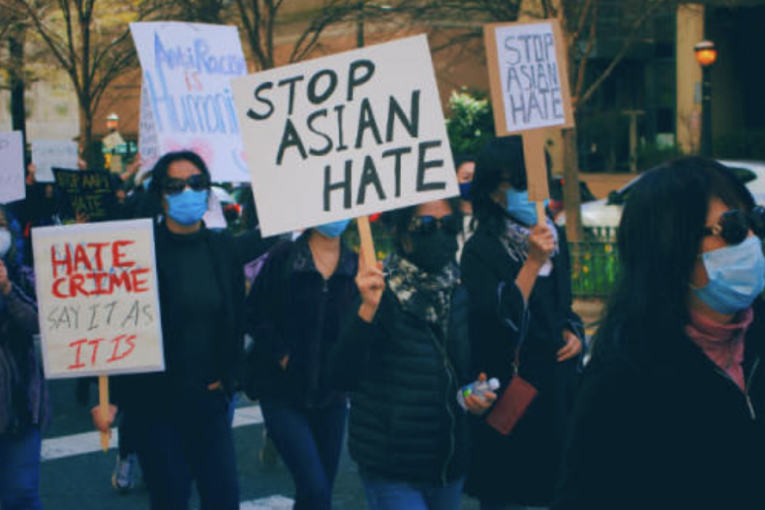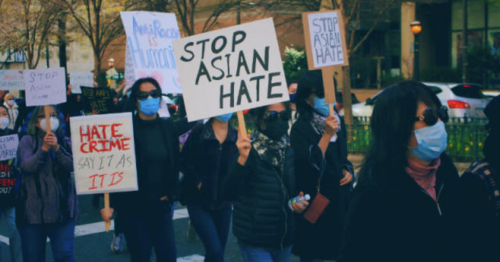

By Ellie Yun
LOS ANGELES — A pair of bills addressing incidents of anti-Asian harassment, including inappropriate gestures or violent verbal hate speech that occur on public transit and in business surroundings, have just been passed into law by California legislative officials.
A surge in hate incidents between 2021 and 2022 has fueled anxiety and concern for general safety in public spaces for many Asian Americans. Organizations like Stop AAPI Hate and California No Place for Hate have united Asian Americans and their allies as part of a movement to mitigate this long-term problem through the establishment of a civil rights infrastructure in several policy arenas.
On Sept. 13, 2022, two bills devoted to vastly reducing public hate and harassment incidents, particularly those targeting Asian Americans and Pacific Islanders, were signed into law by California Governor Gavin Newsom. Both are scheduled to take effect on January 1, 2023.
Stop AAPI Hate, an organization founded in response to the escalation of violence and devoted to “dismantling systemic racism and building a multiracial movement to end […] AAPI hate”, worked with legislative officials to develop the bills.
Across the United States, the number of anti-Asian attacks rose exponentially during the pandemic. According to new research published by the Center for the Study of Hate and Extremism, anti-AAPI hate incidents have increased by 339 percent in 2021 compared to the year before. 40% of these self-reported incidents took place in public spaces — including businesses, grocery stores, public transit, pharmacies, and more — according to data compiled by Stop AAPI Hate.
Both anti-bias measures, known as the No Place for Hate Bills, passed the California State Legislature without any opposition. Cynthia Choi, co-director of Chinese for Affirmative Action and appointed member of the Commission on the State of Hate, lobbied Newsom to sign the two bills as an effort to address public harassment and ensure the safety of the general public no matter one’s racial background or identity.
The Increasing Safety for Public Transit Riders Bill (SB 1161), written by Senator Dave Min (D-Irvine), will require the Mineta Transportation Institute to develop “a survey tool to measure rider demographic information and experiences with safety . . . while waiting at transit stops and riding public transit,” describes California No Place for Hate. SB 1161 aims to strengthen passenger protection in public transit by establishing a statewide standard for a safe rider experience.
The Assembly Bill (AB 2448), authored by Assembly member Phil Ting (D-San Francisco), calls for California’s Civil Rights Department to create a “program to encourage businesses to train their employees not to discriminate against customers and to inform customers of their rights.” AB 2448 aims to foster welcoming and safe business environments.
Yet, there are legal constraints towards seeking solutions to the evident surge of hate towards the AAPI community. “The vast majority of incidents reported to us do not involve an underlying criminal element,” said Manjusha Kulkarni, co-founder of Stop AAPI Hate. This means that although these incidents induce significant trauma and fear amongst individuals in the AAPI community, they do not legally constitute hate crimes and thus cannot be investigated or prosecuted as such, according to Stop AAPI Hate.
As media coverage and attention on these hate incidents have substantially heightened, individuals of Asian descent have actually risen across the sectors of entertainment, politics, and sports. “People saw that Asian Americans are able to tell their own stories, that we can … demand recognition as members of this country,” Pawan Dhingra, president of the Association for Asian American Studies, told Axios.
In the past two years, the AAPI community has united to share their stories, shift the attitudes of the general public to understand that anti-AAPI hate is a long-term problem and lead people towards viable solutions aimed at establishing equality for all. The general public has come to see that people of Asian descent are capable of representing those of all communities and are thus worth electing — in Boston, Michelle Wu was chosen as mayor; in New York City, five Asian Americans were elected to the city council; and at the Oscars, Chloe Zhao became the first woman of color and AAPI descent to win Best Director.
Despite high levels of visibility following the spike in anti-Asian hate incidents, which emerged in part due to faulty blame being placed on people of Asian Americans for the COVID-19 pandemic, such visibility and mass media coverage tend to die down subsequent to the extensive publicity.
Although inspired by the eminent rise in hate directed towards Asians, the No Place for Hate Bills extend their benefits towards Black Americans, the LGBTQ+ community, and other minorities and marginalized people in California who may also experience street harassment on public transit.
In addition to the bill signings, California has established a Commission on the State of Hate and the state’s first Racial Equity Commission. According to the governor’s office, the commission will “create a Racial Equity Framework consisting of resources and tools to promote racial equity and address structural racism.” Newsom recently appointed a Los Angeles transgender advocate as a member of the Commission on the State of Hate.
The new legislation opens opportunities for a proper civil rights infrastructure and ensuing enforcement mechanisms to be established. In addition, an expansion of national mental health services providing relief for depression, anxiety, or stress is a necessity, as these come hand in hand with the experience of hate incidents and harassment.
“This is really hundreds of years of work that’s been in the making . . . that we have to undo”, Cynthia Choi, the co-founder of Stop AAPI Hate, explains. As a community, people must be committed to a long-term vision for change.
Although this campaign is far from over, the new laws are a step in the right direction — where improved policies and embedded equity analysis addressing anti-AAPI harassment can be better developed to ensure that vulnerable individuals feel safer in public spaces.





Articles such as this (as well as the title of the bill itself) are the reason that some mistakenly believe that “hate incidents” are illegal. They’re not.
I believe that it actually creates more problems and danger, to spread misinformation regarding what the law allows.
The bill itself does not make these incidents illegal. The state itself knows better than to try to do so, as it would get summarily tossed out by the court system. As a result, they try to “hide” what the bill actually does (e.g., via a misleading title, etc.).
Actually, the titles of most bills are pretty misleading. “Inflation Reduction Act” comes to mind.
It does nothing of the sort. There is no “enforcement mechanism” regarding legal behavior. Again, this type of claim is creating a problematic, and possibly dangerous “expectation”.
What the bills actually do is apparently outlined in other paragraphs in this article.
Is the claim here that one “marginalized” group is NOT causing problems for another “marginalized” group? And that all of these groups are primarily the target of “white” people? The facts don’t bear that out.
A street has recently been renamed in San Francisco, which supports that point. Someone of Thai heritage, who was randomly murdered by a non-white person.
Another rhetorical question I’d ask is whether or not “white” people are also victims of “hate incidents”. (I ask because I can tell you with certainty that they are.) And yet, they’re not “included” in the “victim” groups listed above. Which, through process of elimination, would misleadingly imply that they are the sole perpetrators (and are never victims, themselves).
This implication (in-and-of itself) might qualify as a form of “hate speech”. Or lead to such.
Though I suspect that in adulthood, most white people are able to avoid it more effectively than (mostly non-white) immigrants in particular. Simply by not exposing themselves to sketchy neighborhoods, schools, and public transit. “White flight’, as it were.
Fortunately, it appears that “white flight” is no longer limited to “whites”. It’s actually/increasingly open to anyone who isn’t creating problems for others – and dragging their own lives down in that process.
The FBI provides annual stats on hate crimes…
You’ll notice that anti-White bias is the second largest category.
This apparently addresses hate crimes, not “incidents”. Though the first sentence “mixes” the two phrases.
Oddly-enough, “anti-Asian” hate crimes are exceedingly low on the list.
I suspect that a lot of hate crimes (and “incidents”) aren’t reported at all (and/or, aren’t reported as such). And in fact, a lot of personal crime against others has a racial component – whether or not the underlying “hatred” is explicitly acknowledged by the perpetrator. (Those crimes may also not be “counted” as hate crimes, even though they actually may be.)
It’s five year old data to illustrate a single point – that whites are counted in hate crime statistics.
Tell that to the author of this article (and the referenced group), when she states this:
See earlier comments, regarding that. This type of statement is divisive, non-inclusionary, misleading, and ultimately – racist (via exclusion). More importantly, it falsely paints the “excluded” category as the perpetrator (via process of elimination). As already noted.
It’s unfortunate, as the problem itself is real.
It comes from the same type of mentality that thinks it’s “o.k.” to call white women “Karen”.
My fifth comment for the day.
The data I showed you has nothing to do with the article, it simply responded to your point. As you well know, anti-Asian hate incidents surged starting in 2020, the data I just posted is from 2017.
No… the “deterrent effect” is de minimus… the bills will just increase incarceration and/or fines for stupid jerks… they will not reduce the incidents… after all, they’re stupid jerks, so won’t get the clue…